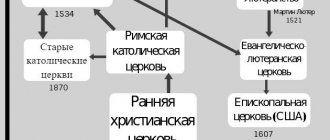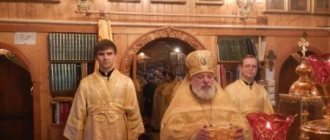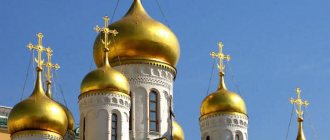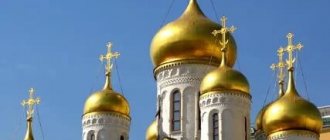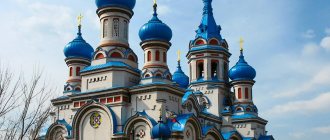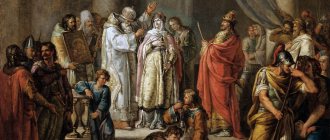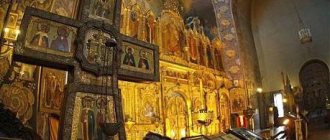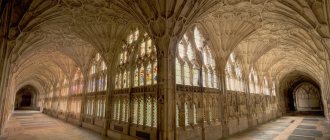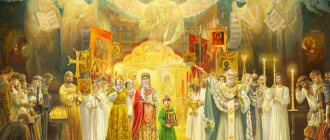The Reformation of the Roman Catholic Church, which occurred in the 16th century, gave birth to a new branch of Christianity - Protestantism. The initiator of the Reformation was the German Martin Luther, who compiled 95 theses on true Christianity.
Within Protestantism itself, many branches have arisen over a long period of time. For example, Lutherans, Calvinists, Anglicans, Baptists, Pentecostals, and Adventists are considered Protestants. But they all have one thing in common: the fundamental differences between their faith and the faith of Catholics and Orthodox Christians.
Eastern Church
The difference between Orthodoxy and Catholicism, since both of these religions are Christian, is not very significant.
However, there are still some differences in teaching, performance of sacraments, etc. We'll talk about which ones a little later. First, let's make a short overview of the main directions of Christianity. Orthodoxy, called the orthodox religion in the West, is currently practiced by about 200 million people. Approximately 5 thousand people are baptized every day. This direction of Christianity spread mainly in Russia, as well as in some CIS countries and Eastern Europe.
The baptism of Rus' took place at the end of the 9th century on the initiative of Prince Vladimir. The ruler of a huge pagan state expressed a desire to marry the daughter of the Byzantine Emperor Vasily II, Anna. But for this he needed to convert to Christianity. An alliance with Byzantium was extremely necessary to strengthen the authority of Rus'. At the end of the summer of 988, a huge number of Kiev residents were baptized in the waters of the Dnieper.
The concept of the Orthodox Church
Orthodox (Christian) is the second largest religious structure in the world, numbering 300,000,000 like-minded people. Its unity is based on the common recognition of faith in Jesus Christ. Consists of local (autonomous, patriarchates) with a central leadership:
- Autonomous: Russian, Georgian, Ukrainian, Greek.
- Patriarchates: Moscow, Constantinople.
Holiness comes from God the Father, which is not subject to destruction by the sins of those who pray. It has universal power, indestructibility, apostolicity, since it is based on the teaching of the apostles sent by God to teach people faith.
The local ones are independent from the central one, but are in the same doctrine with it, and are part of a common centralized structure.
How does a Protestant church building differ from an Orthodox one?
The difference between Protestantism and Orthodoxy is also reflected in the architecture of churches. Orthodox architects adhere to forms that usually go back to ancient models, and the temple can be easily recognized by its dome (or several) with a cross.
The Orthodox Church consists of a vestibule, a middle part and an altar facing East.
In Protestantism, the church can look almost anything, most often the forms of Western architectural styles are used (Romanesque, Gothic, Art Nouveau), eclecticism is common. At the same time, a small part of Protestant churches borrowed the Byzantine style and are very similar in appearance to Orthodox churches.
A comparison of Protestantism and Orthodoxy shows a deep difference between these teachings, which should be taken into account by all people who are in a spiritual search and who turn their gaze towards Christianity.
The difference between Orthodoxy and Catholicism and Protestantism
The difference between Orthodoxy and Catholicism also lies in the fact that the former has remained united and indivisible for almost a millennium. In the Catholic Church in the 14th century. a split occurred. This was connected with the Reformation, a revolutionary movement that arose at that time in Europe. In 1526, at the request of German Lutherans, the Swiss Reichstag issued a decree on the right of free choice of religion for citizens. In 1529
At the moment, Protestantism is widespread mainly in the Scandinavian countries: Canada, USA, England, Switzerland, and the Netherlands. In 1948, the World Council of Churches was created. The total number of Protestants is about 470 million people. There are several denominations of this Christian movement: Baptists, Anglicans, Lutherans, Methodists, Calvinists.
In our time, the World Council of Protestant Churches pursues an active peacemaking policy. Representatives of this religion advocate easing international tension, support the efforts of states to defend peace, etc.
Of course, over the centuries of schism, significant differences have arisen in the traditions of the churches.
They did not touch upon the basic principle of Christianity - accepting Jesus as the Savior and Son of God. However, in relation to certain events of the New and Old Testaments, there are often even mutually exclusive differences. In some cases, the methods of conducting various kinds of rituals and sacraments do not agree. The main differences between Orthodoxy and Catholicism and Protestantism
| Orthodoxy | Catholicism | Protestantism | |||
| Control | Patriarch, Cathedral | Dad | World Council of Churches, councils of bishops | ||
| Organization | Bishops depend little on the Patriarch and are mainly subordinate to the Council | There is a rigid hierarchy with subordination to the Pope, hence the name “Universal Church” | There are many denominations that have created the World Council of Churches. Sacred Scripture is placed above the authority of the Pope | ||
| Holy Spirit | It is believed that it comes only from the Father | There is a dogma that the Holy Spirit comes from both the Father and the Son. This is the main difference between Orthodoxy and Catholicism and Protestantism. | |||
| God the Father | The statement is accepted that man himself is responsible for his sins, and God the Father is a completely impassive and abstract being | It is believed that God suffers because of human sins | |||
| Dogma of Salvation | The Crucifixion atoned for all the sins of mankind. Only the firstborn remained. That is, when a person commits a new sin, he again becomes the object of God’s wrath | The person was, as it were, “ransomed” by Christ through the crucifixion. As a result, God the Father changed his anger to mercy regarding original sin. That is, a person is holy by the holiness of Christ himself | |||
| Divorces | Sometimes allowed | Prohibited | Allowed, but frowned upon | ||
| Immaculate Conception of the Virgin Mary | It is believed that the Mother of God is not free from original sin, but her holiness is recognized | The complete sinlessness of the Virgin Mary is preached. Catholics believe that she was conceived immaculately, like Christ himself. In relation to the original sin of the Mother of God, therefore, there are also quite significant differences between Orthodoxy and Catholicism | Absolutely not accepted | ||
| Assumption of the Virgin Mary into Heaven | It is unofficially believed that this event may have taken place, but it is not enshrined in dogma | The assumption of the Mother of God into heaven in a physical body is a dogma | The cult of the Virgin Mary is denied | ||
| Ritual | Only liturgy is held | Both a mass and a Byzantine liturgy similar to the Orthodox can be celebrated | The mass was rejected. Divine services are held in modest churches or even in stadiums, concert halls, etc. Only two rites are practiced: baptism and communion | ||
| Clergy marriage | Allowed | Allowed only in the Byzantine rite | Allowed | ||
| Ecumenical Councils | The decisions of the first seven | Guided by 21 decisions (the last one passed in 1962-1965) | Recognize the decisions of all Ecumenical Councils if they do not contradict each other and the Holy Scriptures | ||
| Cross | Eight-pointed with crossbars at the bottom and top | A simple four-pointed Latin cross is used | Not used in religious services. Not worn by representatives of all faiths | ||
| Icons | Used in large quantities and equated with Holy Scripture. Created in strict accordance with church canons | They are considered only decoration of the temple. They are ordinary paintings on a religious theme | Not used | ||
| Old Testament | Both Hebrew and Greek are recognized | Greek only | Only Jewish canonical | ||
| Absolution | The ritual is performed by a priest | Not allowed | |||
| Science and religion | Based on the statements of scientists, dogmas never change | Dogmas can be adjusted in accordance with the point of view of official science | |||
We suggest you familiarize yourself with: Prophets in Christianity, list in order, how many prophecies are there in the Bible?
Reformation for dummies
Alexey Chernega October 31, 2017
The Reformation, a movement to rethink the Christian (or more precisely, Catholic) church, goes far beyond religion and concerns both social and political life. Although the Reformation originated in Germany, it spread throughout Europe.
The beginning of the Reformation is considered to be October 31, 1517, when Martin Luther, Doctor of Theology at the University of Wittenberg, nailed his famous “95 Theses” to the doors of the Castle Church. In them he spoke out against the abuse of power of the Catholic Church and the sale of indulgences.
In those days, the Catholic Church played not only a religious, but also a political role, so the reasons for the Reformation lay far beyond religion. A new class was emerging - the bourgeoisie - which opposed the feudal lords. The Catholic Church itself was a major feudal lord and, accordingly, supported the existing hierarchy.
The new class needed a new church, and Luther's ideas about simplicity and economy resonated with the bourgeoisie. It is important that representatives of the new class did not want to abandon the Christian worldview.
Who was Martin Luther and why is he considered the father of the Reformation?
Martin Luther came from a peasant family who was able to become rich. Luther was brought up in strictness. His father sought to give him a legal education, but unexpectedly for the family, the son became a monk of the Augustinian Order, and then a priest. Luther taught at the new university in Wittenberg and received his doctorate in theology. Once, on business, he was sent to Rome, where he allegedly saw the depravity of the Roman Catholic priests. Luther came to the conclusion that the papacy was not needed to understand God.
The reason Luther posted his 95 Theses on the church door was because of Pope Leo X's bull on the sale of indulgences. Luther was not the first to criticize the remission of sins for money, but it was he who dared to criticize Catholic dogmas - for example, that the church is a necessary mediator between God and man.
Then events developed rapidly: Luther was summoned to court, anathematized, and then completely declared a heretic. Luther publicly burns the papal bull in the university courtyard and says that now the fight against the papacy is the work of the entire German nation.
Luther was not executed. During the 62 years of his life, he managed to publish several works and translate the Bible into German - this translation played a key role in the Reformation and became the basis of the German literary language.
Lutherans and Protestants - what's the difference?
Lutherans are a Protestant movement. Together with Calvinism, Anabaptism, Zwinglianism and Anglicanism, Lutheranism belongs to the churches of the Reformation. Various pre-Reformation movements (for example, the Hussites) and churches that arose after the Reformation (Baptists and Methodists) are also considered Protestant.
However, it is not so shameful to confuse Lutheranism and Protestantism. Initially, it was Luther’s supporters who began to be called Protestants - after their protest in the German city of Speyer. The term "Lutherans" was first used in texts against Luther and his supporters - and in a negative sense.
Lutheran and Catholic Church - what is the difference
Lutherans do not recognize the clergy as God's representatives on earth, but this does not mean that they have completely abandoned the institution of the priesthood. Lutheran priests are considered pastors, that is, preachers who do not rise above the laity in any way. Can a woman become a minister in the Lutheran Church? Yes maybe. And even a lesbian woman - and this will not surprise anyone. In the Lutheran Church of Sweden, for example, a homosexual couple can enter into the same marriage as a heterosexual one.
Lutheran churches often look more modern than Catholic ones - there are no rich decorations, icons and paintings. However, this is not always true - in ancient Lutheran churches you can find magnificent decoration of the altar, paintings, and candles.
Lutherans recognize two sacraments (Catholics have seven) - baptism and communion, since they were established by Jesus Christ himself. However, the Lutheran book “Apology of the Augsburg Confession” also classifies confession and ordination as sacraments.
The Reformation began in Germany. Are most Germans Lutherans?
No. The Treaty of Westphalia divided Germany into two zones - Catholic and Lutheran.
Until now, there are approximately equal numbers of Catholics and Lutherans in Germany. The Evangelical Church - a union of Lutheran and Reformed (Calvinist) state churches - in Germany has about 25 million parishioners.
This is 30% of the country's population. There are approximately the same number of Catholics in the country. The most influential Catholic archdiocese is in Cologne.
Even more interesting things in our Yandex.Zen channel. Subscribe!
Ritual and canonical differences
Religions are located in different countries and parts of the world, therefore they differ in the type of worship and rituals:
- an Orthodox priest in prayer speaks of himself as a “witness of God,” while in Catholicism he is endowed with the power to “baptize people” and “perform the Sacrament”;
- in Catholic churches there is an altar without an iconostasis;
- In Catholicism, portrait iconography is common (Jesus Christ, Holy Mary), among Christians, the Saints are depicted in heaven, with God, therefore the icons are dominated by blue, blue tones depicting the sky;
- various structures. Catholicism is the sole authority of the Pope, Orthodoxy is the sacrament-preserving dogmas and laws;
- The Pope is infallible. He cannot commit unrighteous acts, since he is the vicegerent of God;
- In Orthodoxy, infallibility is inherent in the decisions of the Ecumenical Council - a general meeting of representatives of patriarchates and independent churches.
Conclusions TheDifference.ru
- In Catholicism, there is an organizational unity of believers, cemented by the authority of the Pope. Protestants have no unity, and there is no head of the church.
- Catholics can only have men as clergy; Protestants also have women among their clergy.
- Catholics are baptized at any age, Protestants - only in adulthood.
- Protestants deny the Holy Tradition.
- Catholics recognize the cult of the Virgin Mary. For Protestants, the Virgin Mary is just a perfect woman. There is also no cult of saints.
- Catholics have seven sacraments of the church, Protestants have only two, and in some movements, none.
- Catholics have a concept of posthumous suffering of the soul. Protestants believe only in the Last Judgment.
- Catholics receive communion on unleavened bread; for Protestants, the type of communion bread is unimportant.
- Catholics confess in the presence of a priest, Protestants - without an intermediary before God.
- Protestants do not have a special form of worship.
- Protestants do not recognize icons, the cross, or venerate the relics of saints, as is customary among Catholics.
Differences between Catholicism and Orthodoxy
- Unlike Catholicism, Orthodoxy believes that the Holy Spirit comes only from God the Father, as stated in the Creed.
- In Orthodoxy, only monastics observe celibacy; the rest of the clergy can marry.
- The sacred tradition of the Orthodox does not include, in addition to the ancient oral tradition, the decisions of the first seven Ecumenical Councils, the decisions of subsequent church councils, or papal messages.
- There is no dogma of purgatory in Orthodoxy.
- Orthodoxy does not recognize the doctrine of the “treasury of grace” - the overabundance of good deeds of Christ, the apostles, and the Virgin Mary, which allow one to “draw” salvation from this treasury. It was this teaching that allowed for the possibility of indulgences, which at one time became a stumbling block between Catholics and future Protestants. Indulgences were one of those phenomena in Catholicism that deeply outraged Martin Luther. His plans included not the creation of new denominations, but the reformation of Catholicism.
- In Orthodoxy, the laity Communicate with the Body and Blood of Christ: “Take, eat: this is My Body, and drink from it, all of you: this is My Blood.”
Table of differences between crosses
Disagreements regarding the descent of the Holy Spirit are the main difference between Orthodoxy and Catholicism. The table also shows many other, albeit not very significant, but still discrepancies. They arose a long time ago, and, apparently, none of the churches expresses any particular desire to resolve these contradictions.
There are also differences in the attributes of different directions of Christianity. For example, the Catholic cross has a simple quadrangular shape. The Orthodox have eight points. The Orthodox Eastern Church believes that this type of crucifix most accurately conveys the shape of the cross described in the New Testament. In addition to the main horizontal crossbar, it contains two more.
The image of the Savior on the crucifix used in the Sacraments is also something that can be attributed to the topic “the difference between Orthodoxy and Catholicism.” The western cross is a little different from the eastern one.
We suggest you familiarize yourself with: Human eye colors table
Differences between crosses
| Orthodox | Catholic |
| Eight- or six-pointed | Four-pointed |
| Christ is depicted alive, having conquered death | The bas-relief of Jesus is naturalistic. Sometimes even streams of blood can be depicted |
| The words on the top plate are written in Slavic-Russian | Words INRI - in Latin |
| Jesus' feet are positioned separately. Each one of them is nailed to a crucifix | Legs put together and nailed with one nail |
As you can see, with regard to the cross there is also a very noticeable difference between Orthodoxy and Catholicism. The table shows this clearly.
As for Protestants, they consider the cross to be a symbol of the Pope, and therefore practically do not use it.
So, the difference between Orthodoxy and Catholicism and Protestantism (the table of comparisons of crosses confirms this) with regard to attributes is quite noticeable. There are even greater differences in these directions in icons. The rules for depicting Christ, the Mother of God, saints, etc. may differ.
Below are the main differences.
Differences in icons
| Orthodox | Catholic | |
| Hands of the saints | The right one lies on top of the left one | Left over right |
| Eyes | Humbly covered | "Surprised" look |
| Robe of the Virgin Mary | Bright, golden | Black robe over white |
| Signatures | In most cases there are no | In Latin |
The main difference between an Orthodox icon and a Catholic one is that it is painted in strict accordance with the canons established in Byzantium. Western images of saints, Christ, etc., strictly speaking, have nothing to do with the icon. Typically, such paintings have a very broad subject and were painted by ordinary, non-church artists.
Protestants consider icons to be a pagan attribute and do not use them at all.
Evangelical Christians, Orthodox and Catholics - similarities and differences
Evangelical Christians are Christians who belong to one of several independent Christian churches. Evangelical Christians, Catholics and Orthodox Christians, adhere to the fundamental principles of Christianity. For example, they all accept the Nicene-Constantinopolitan Creed, adopted by the first Council of the Church in 325. They all believe in the death, burial and resurrection of Jesus Christ, in His divine essence and future coming. All three schools accept the Bible as the Word of God and agree that repentance and faith are necessary to have eternal life and escape hell. According to Operation Peace, there are about a billion evangelical Christians, more than a billion Catholics and 250 million Orthodox Christians worldwide. However, the views of Catholics, Orthodox and Evangelical Christians on some issues differ. Evangelical Christians value above all else the authority of the Bible and the right of every person to understand it without the mediation of a special caste of priests. Orthodox and Catholics value their traditions above the authority of the Bible, and also claim that only the leaders of these Churches can interpret the Bible correctly. The main differences between these three faiths are rooted in this fundamental fact. Below are answers to some questions you may have about the differences between the Orthodox, Catholic and Protestant Churches, but first a brief history of evangelical Christians.
One of the first reformers of Evangelical Christians was priest, professor of theology Jan Hus, a Slav who lived in the territory of modern Czech Republic and became a martyr for the faith in 1415. Hus taught that Scripture is more important than tradition. Later, starting in 1517, the Reformation spread throughout Europe when another Catholic priest and theology professor named Martin Luther called for renewal of the Catholic Church. He said that when the Bible conflicts with church traditions, the Bible must be obeyed. Luther said that the Church was doing wrong by selling the opportunity to go to heaven for money. He also believed that salvation came through faith in Christ and not through trying to “earn” eternal life through good works. For the first time, Evangelical Christians came to Russia during the time of Ivan the Terrible and by 1590 they were already in Siberia, in Tobolsk.
NOTE: "Neither Catholics, Orthodox, nor Evangelical Christians recognize Jehovah's Witnesses, Mormons, and Moonies as Christian churches."
Most Protestants are called evangelical Christians because the Apostle Paul himself calls our faith evangelical: “contending with one accord for the faith of the gospel” (Phil. 1:27).
Evangelical Christians have nothing against church traditions unless those traditions contradict Scripture. They substantiate this primarily with the remarks of Jesus in the Gospel of Mark (7:8): “For you, having abandoned the commandment of God, hold to the tradition of men...”, and in the Gospel of Matthew (15:3, 6): “...Why do you transgress the commandment of God for the sake of your tradition?... Thus you have made the commandment of God null and void by your tradition.”
Most evangelical Christians believe that children automatically go to heaven when they die. They also believe in the Bible's statement that baptism must follow repentance. They base this belief on the Second Book of Samuel (12:23), which describes the death of King David's infant son. David confidently says that the time will come - and he will see his son in heaven. The Bible also says that children do not know good and evil (Deut. 1:39). In the Epistle to the Romans (5:13) it is written: “...But sin is not imputed when there is no law.” Jesus said: “Let the children come and do not hinder them from coming to Me, for of such is the kingdom of heaven” (Matthew 19:14). Protestants say that the Bible does not describe a single case of infant baptism, especially since even Jesus waited until he was 30 to be baptized.
Evangelical Christians believe that the Ten Commandments (Ex. 20:4) prohibit the use of images for worship: “You shall not make for yourself any graven image or any likeness of anything that is in heaven above, or that is in the earth beneath, or that is in the water under the earth.” Leviticus 26:1 says: “You shall not make idols or graven images for yourselves, neither shall you set up pillars for yourselves, nor shall you place gravestones with images on your land to bow down to them; for I am the Lord your God.” In Deuteronomy (4:15-16) the Lord says: “Keep it firmly in your souls that you did not see any image in the day that the Lord spoke to you at (Mount) Horeb out of the midst of the fire, lest you turn aside and do yourself sculptures, images of some idol...” Therefore, evangelical Christians do not use images for worship for fear that some people may worship these images instead of God.
Evangelical Christians prefer to follow the instructions of Jesus Christ, where He taught us to pray by saying: “Pray thus: Our Father which art in heaven...” (Matt. 6:9). Evangelical Christians say there are no examples in Scripture of anyone praying to Mary or the saints. They believe that the Bible forbids praying to people who have died, even to Christians in heaven. They base this belief on the book of Deuteronomy (18:10-12), which says: “You shall not have anyone... who inquires of the dead.” God condemned Saul for contacting Saint Samuel after his death (1 Chron. 10:13-14), as well as many other places in Scripture.
Evangelical Christians believe that Mary was a perfect example of Christian obedience to God and that she remained a virgin until Jesus was born. The basis for this is the Gospel of Matthew (1:25), which says that Joseph, her husband, “knew her not before she gave birth to her firstborn Son,” and other passages from the Bible that talk about the brothers and sisters of Jesus ( Matthew 12:46, 13:55-56, Mark 3:31, John 2:12, 7:3). Evangelical Christians do not believe that Mary was sinless because in Luke 1:47 she named God as her Savior; but she would not need a Savior if she were without sin.
Evangelical Christians believe that there is only one true Church, but do not believe that it is part of any man-made organization. This true Church consists of all Christians and local churches who love and serve God through repentance and faith in Jesus Christ. Because Jesus Christ said that “not everyone who says to Me, “Lord!” Lord!” will enter the Kingdom of Heaven, but he who does the will of My Father in heaven” (Matthew 7:15,16,21).
Evangelical Christians accept most of the decisions of historical church councils, but do not consider them infallible. This attitude is based on the fact that some decrees, in particular those adopted at the last two Councils of Nicaea, contradict each other on the issue of icons. At the first of them, held in 754, the use of icons was completely prohibited in the church, while at the second, in 787, it was decided that icons should be used. Evangelical Christians accept the decisions of Councils only when they are consistent with the teachings of the Bible.
Evangelical Christians respect and value the teachings of the Church Fathers (church leaders who lived after the apostles) when those teachings are in agreement with Scripture. This is based on the fact that often the Church Fathers do not agree with each other.
Evangelical Christians do not believe that the relics of saints contain any special power because the Bible does not teach this. Evangelical Christians believe that the incident with the bones of Elisha, which resurrected the dead (2 Kings 13:21), was nothing more than the fulfillment of God’s promise to give Elisha double the spirit that was on Elijah (2 Kings 2:9). The miracle that occurred after Elisha's death was just twice the number of miracles performed by Elijah. Evangelical Christians believe that the Bible does not indicate that Christians should honor the bodies of the dead.
Ministers of Evangelical Christians do not wear cassocks because neither Jesus nor the apostles wore any special clothing; there is also no indication in this regard in the New Testament. They are not usually called “father” because Jesus said in the Gospel of Matthew (23:9): “And call no one on earth your father...”.
Evangelical Christians do not object to the sign of the cross, but since Scripture does not teach it, they do not teach it either.
Evangelical Christians and Catholics believe that the iconostasis symbolizes the veil separating people from the Holy of Holies in the Jerusalem Temple. They believe that when God tore it in two at the death of Jesus (Matt. 27:51), He was saying that we are no longer separated from Him because of the blood He shed so that we would be forgiven if we repented. and let us believe in Christ for our salvation.
Jesus said in Matthew 18:20, “For where two or three are gathered together in My name, there am I in the midst of them.” Evangelical Christians believe that worship is sanctified not by the location of the service or the building, but by the presence of Christ among the believers. The Bible also says that Christians are the temple of God, not buildings: “Do you not know that you are the temple of God, and that the Spirit of God dwells in you?” states the Apostle Paul (1 Cor. 3:16). The Bible shows that the early Christians held services in many different places: in the school (Acts 19:9), in the Jewish synagogues (Acts 18:4, 26; 19:8), in the Jewish temple (Acts 3:1), and in private homes (Acts 2:46; 5:42; 18:7; Phil. 1:2; 18:7; Col. 4:15; Rom. 16:5 and 1 Cor. 16:19) . Evangelism services, according to the Bible, took place near the river (Acts 16:13), in the street crowd (Acts 2:14), and in the public square (Acts 17:17).
The Apostle Peter, when asked a similar question (Acts 2:37-38), responded this way: “Repent, and be baptized every one of you in the name of Jesus Christ for the forgiveness of sins.” In the Gospel of Mark (16:16), the Lord Jesus said: “Whoever believes and is baptized will be saved; and whoever does not believe will be condemned.” The Apostle Paul wrote in Ephesians (2:8-9): “For by grace you have been saved, through faith; and this not of yourselves, it is the gift of God; not by works, so that no one can boast.”
Difference between Catholics and Orthodox
| Difference | Orthodoxy | Catholicism |
| Structure | Individual patriarchates, churches | Everyone obeys the Pope |
| Belief in infallibility | Ecumenical Councils (general meetings) | Pope |
| Symbol of faith | The Holy Trinity is indivisible (Father, Son, Holy Spirit) | Holy Spirit - from the Father, the Son |
| Attitude to divorces and weddings | Allowed | Not allowed |
| Confession | Personally with the priest | The clergyman's face is covered with a special partition so as not to embarrass the confessor |
| Indulgence (purchase of forgiveness of future sin) | No idea | Eat |
| Purgatory | Private judgment of the soul after death | Exists |
| Priest's name | Father, father (name of clergyman) | Holy father |
| Divine service | Liturgy | Mass |
| Cleansing | Bread, wine | Bread, wafer |
| Believers' Prayer | Standing promotes greater concentration of actions | Sitting |
| Celibacy | Monks | All clergy |
| Differences in holidays | Holy Mother of God, Trinity, Palm Sunday, etc. | Heart of Jesus, Immaculate Heart of Mary, etc. |
| Type of cross | Four bars on a cross | One (two) crossbars |
| Celebration of major holidays | Christmas from 6 to 7 January | Christmas celebration from December 24−25 |
| How believers are baptized | Right hand 3 fingers from right to left | 5 fingers with open palm from left to right |
Monasticism
With regard to leaving worldly life and devoting oneself to serving God, there is also a significant difference between Orthodoxy and Catholicism and Protestantism. The comparison table above shows only the main differences. But there are other differences, also quite noticeable.
For example, in our country, each monastery is practically autonomous and subordinate only to its own bishop. Catholics have a different organization in this regard. The monasteries are united into so-called Orders, each of which has its own head and its own charter. These associations may be scattered throughout the world, but nevertheless they always have a common leadership.
Protestants, unlike Orthodox and Catholics, completely reject monasticism. One of the inspirers of this teaching, Luther, even married a nun.
We invite you to familiarize yourself with: Table of Pythagoras by year of birth
Church Sacraments
There is a difference between Orthodoxy and Catholicism in relation to the rules for conducting various kinds of rituals. Both of these Churches have 7 sacraments. The difference lies primarily in the meaning attached to the main Christian rituals. Catholics believe that the sacraments are valid whether a person is in tune with them or not.
According to the Orthodox Church, baptism, confirmation, etc. will be effective only for believers who are completely disposed towards them. Orthodox priests even often compare Catholic rituals with some kind of pagan magical ritual that operates regardless of whether a person believes in God or not.
The Protestant Church practices only two sacraments: baptism and communion. Representatives of this trend consider everything else superficial and reject it.
We have examined the main differences between Orthodoxy and Catholicism. This refers to the descent of the Holy Spirit and the virginity of the birth of the Virgin Mary. Such significant differences have emerged over centuries of schism. Of course, they also exist in the celebration of one of the main Christian sacraments - the Eucharist. Catholic priests administer communion only with unleavened bread. This church product is called wafers. In Orthodoxy, the sacrament of the Eucharist is celebrated with wine and ordinary yeast bread.
In Protestantism, not only members of the Church, but also anyone who wishes, are allowed to receive communion. Representatives of this direction of Christianity celebrate the Eucharist in the same way as the Orthodox - with wine and bread.
Can Christians go to church?
Orthodox Christians can attend Catholic Mass and pray, but they cannot proceed to the Sacrament of the Eucharist or confess to a Catholic priest. In general, having the same structure as an Orthodox church, a Catholic cathedral is somewhat different. ... You cannot walk around the church during Mass.
Interesting materials:
How to give Nimulid to a child? How to make babies in Sims 4? How to add a child to the Sims 4 family? How to add a child to Uchiru? How long can you carry a child? How long should parents support their children? How long does it take for a child’s collarbone to heal? How long does it take to heal after a baby's circumcision? How long to wait for child benefits? How does the baby move at 23 weeks?
Baptism
This main Christian sacrament is recognized by all churches: Orthodoxy, Catholicism, Protestantism. The only differences are in the methods of performing the ritual.
In Catholicism, it is customary for infants to be sprinkled or doused. According to the dogmas of the Orthodox Church, children are completely immersed in water. Recently there has been some movement away from this rule. However, now the Russian Orthodox Church is again returning in this rite to the ancient traditions established by Byzantine priests.
The difference between Orthodoxy and Catholicism (crosses worn on the body, like large ones, may contain the image of an “orthodox” or “Western” Christ) in relation to the performance of this sacrament is therefore not very significant, but it still exists.
Protestants usually perform baptism with water. But in some denominations it is not used. The main difference between Protestant baptism and Orthodox and Catholic baptism is that it is carried out exclusively for adults.

